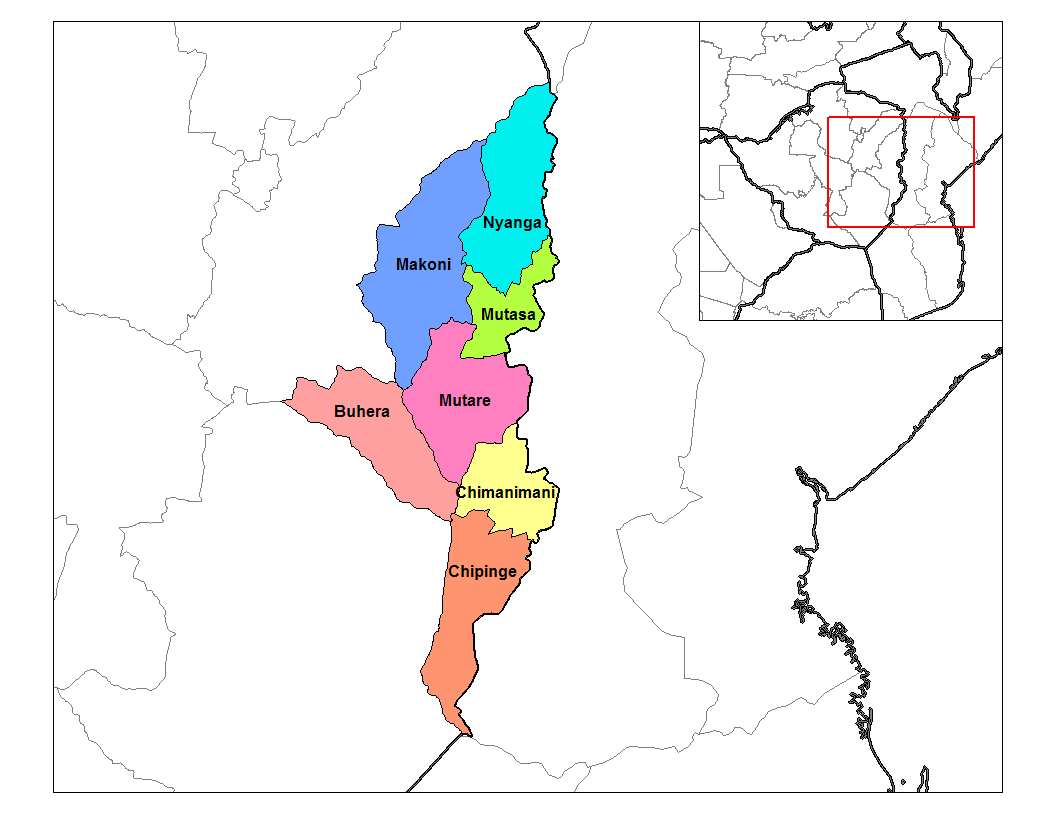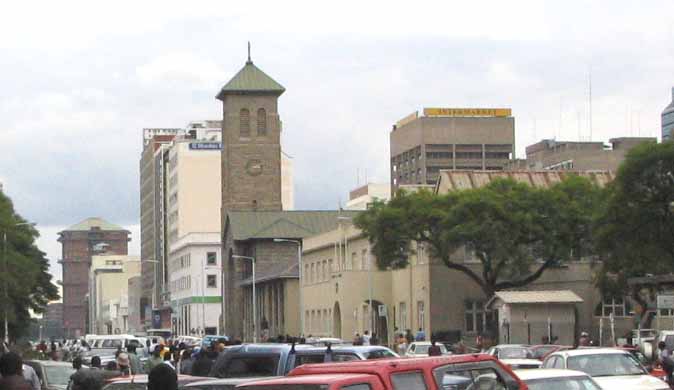|
Mutare District
Mutare District is a district in Manicaland Province of eastern Zimbabwe. The district headquarters is the city of Mutare. Geography The district has a rural area of 5,523 km², and an urban area of 191 km². It is bounded on the east by Mozambique, on the northeast by Mutasa District, on the northwest by Makoni District, on the southwest by Buhera District, and on the southeast by Chimanimani District. The city of Mutare is located in the northeastern corner of the district, near the border with Mozambique. Mutare is the largest city in the district, and the fourth-largest city in Zimbabwe. Other towns include Chiadzwa and Odzi. The Eastern Highlands extend north and south through eastern portion of the district, along the border with Mozambique. The Bvumba Mountains form a part of the highlands, and rise southeast of Mutare city. The highest peak is Castle Beacon at 1,911 metres. The Bunga Forest Botanical Reserve conserves the mountains' high-elevation mist forest. ... [...More Info...] [...Related Items...] OR: [Wikipedia] [Google] [Baidu] |
Manicaland Districts
Manicaland is a province in eastern Zimbabwe. After Harare Province, it is the country's second-most populous province, with a population of 2.037 million, as of the 2022 census. After Harare and Bulawayo provinces, it is Zimbabwe's third-most densely populated province. Manicaland was one of five original provinces established in Southern Rhodesia in the early colonial period. The province endowed with country's major tourist attractions, the likes of Mutarazi Falls, Nyanga National Park and Zimbabwe's top three highest peaks. The province is divided into ten administrative subdivisions of seven rural districts and three towns/councils, including the provincial capital, Mutare. The name Manicaland is derived from one of the province's largest ethnic groups, the Manyika, who originate from the area north of the Manicaland province and as well as western Mozambique, who speak a distinct language called ChiManyika in Shona (one of the dialect of the Shona language). Manicaland is b ... [...More Info...] [...Related Items...] OR: [Wikipedia] [Google] [Baidu] |
Odzi River
The Odzi River is a tributary of the Save River in Zimbabwe. It joins the latter river at Nyanyadzi. It is dammed at Osborne Dam. The Odzani River is a westward-flowing tributary of the Odzi, rising near Penhalonga north of the city of Mutare Mutare (formerly Umtali) is the most populous city in the province of Manicaland, and the third most populous city in Zimbabwe, having surpassed Gweru in the 2012 census, with an urban area, urban population of 224,802 and approximately 260,567 .... The Odzani and Smallbridge dams on the Ozani are part of the water-supply system for Mutare."Zimbabwe Dam Safety Study". Policy Note 8, Zimbabwe Water Forum, November 2013. Accessed 12 April 202/ref> Odzani Dam, constructed in 1967, created Lake Alexander. References Geography of Manicaland Province Rivers of Zimbabwe Save River (Africa) {{Zimbabwe-river-stub ... [...More Info...] [...Related Items...] OR: [Wikipedia] [Google] [Baidu] |
Harare
Harare (; formerly Salisbury ) is the capital and most populous city of Zimbabwe. The city proper has an area of 940 km2 (371 mi2) and a population of 2.12 million in the 2012 census and an estimated 3.12 million in its metropolitan area in 2019. Situated in north-eastern Zimbabwe in the country's Mashonaland region, Harare is a metropolitan province, which also incorporates the municipalities of Chitungwiza and Epworth. The city sits on a plateau at an elevation of above sea level and its climate falls into the subtropical highland category. The city was founded in 1890 by the Pioneer Column, a small military force of the British South Africa Company, and named Fort Salisbury after the UK Prime Minister Lord Salisbury. Company administrators demarcated the city and ran it until Southern Rhodesia achieved responsible government in 1923. Salisbury was thereafter the seat of the Southern Rhodesian (later Rhodesian) government and, between 1953 and 1963, th ... [...More Info...] [...Related Items...] OR: [Wikipedia] [Google] [Baidu] |
Senate Of Zimbabwe
The Senate of Zimbabwe is the upper of the two chambers in Zimbabwe's Parliament. It existed from independence in 1980 until 1989, and was re-introduced in November 2005. The other chamber of Parliament is the National Assembly. In its current form, the Senate has 80 members. Of these, 60 members are elected from 10 six-member constituencies (based on the provinces) by proportional representation using party lists; the lists must have a woman at the top and alternate between men and women. The other 20 seats include two reserved for people with disabilities and 18 for traditional chiefs. History before abolition The original Senate consisted of 40 members, the majority of whom were elected by the House of Assembly (the directly elected lower chamber), with the remainder being chosen by the Council of Chiefs and appointed by the President. Under the Lancaster House Agreement, 20% of seats in both chambers were reserved for whites, until 1987. It was abolished in 1989 with Co ... [...More Info...] [...Related Items...] OR: [Wikipedia] [Google] [Baidu] |
Mutasa South
Mutasa South is a constituency of the National Assembly of the Parliament of Zimbabwe, located in Manicaland Province. Its current MP since a 2022 by-election is Misheck Mugadza of ZANU–PF. The seat was previous represented by Regai Tsunga of the Movement for Democratic Change Alliance until he was recalled in 2021. History Mutasa South is a constituency of Zimbabwe in the province of Manicaland.Mutasa South Constituency Profile It is also the central area of the . In the 2005 general election the candidate of the was declared the ... [...More Info...] [...Related Items...] OR: [Wikipedia] [Google] [Baidu] |
Mutare West
Mutare West is a constituency represented in the National Assembly of the Parliament of Zimbabwe, located in Manicaland Province. Its current MP since the 2023 general election is Nyasha Marange of ZANU–PF. Electoral history The candidate of the ZANU–PF was declared the winner in the March 2005 parliamentary election, despite irregularities. In the March 2008 parliamentary election, Movement for Democratic Change candidate Shuah Mudiwa very narrowly won the seat, receiving 7,597 votes against 7,577 votes for Chris Mushohwe, the Minister of Transport and Communications, according to official results. Mushowe despite losing the parliamentary seat was elevated to the level of provincial Governor. An independent candidate, Gideon Chamuka, received 536 votes. , newzimbabwe.com. In ... [...More Info...] [...Related Items...] OR: [Wikipedia] [Google] [Baidu] |
Mutare South
Mutare South is a constituency of the National Assembly of the Parliament of Zimbabwe, located in Manicaland Province. Its current MP since the 2018 election is Jefrey Ngome of ZANU–PF The Zimbabwe African National Union – Patriotic Front (ZANU–PF) is a political organisation which has been the ruling party of Zimbabwe since independence in 1980. The party was led for many years under Robert Mugabe, first as prime ministe .... References Mutare District Parliamentary constituencies in Zimbabwe {{Zimbabwe-geo-stub ... [...More Info...] [...Related Items...] OR: [Wikipedia] [Google] [Baidu] |
Mutare North
Mutare (formerly Umtali) is the most populous city in the province of Manicaland, and the third most populous city in Zimbabwe, having surpassed Gweru in the 2012 census, with an urban population of 224,802 and approximately 260,567 in the surrounding districts giving the wider metropolitan area a total population of over 500,000 people.http://www.zimstat.co.zw/wp-content/uploads/publications/Population/population/census-2012-national-report.pdf Mutare is also the capital of Manicaland province and the largest city in Eastern Zimbabwe. Located near the border with Mozambique, Mutare has long been a centre of trade and a key terminus en route to the port of Beira (in Beira, Mozambique). Mutare is hub for trade with railway links, pipeline transport and highways linking the coast with Harare and the interior. Other traditional industries include timber, papermaking, commerce, food processing, telecommunications, and transportation. In addition the city serves as a gateway to t ... [...More Info...] [...Related Items...] OR: [Wikipedia] [Google] [Baidu] |
Mutare Central
Mutare Central is a constituency represented in the National Assembly of the Parliament of Zimbabwe, located in Mutare in Manicaland Province. Its current MP since the 2023 general election is Brian James of the Citizens Coalition for Change, the former mayor of Mutare. The constituency was previously represented between 2000 and 2023 by Innocent Gonese. Members Electoral history In the 2008 parliamentary election the seat was won by the MDC candidate loyal to Morgan Tsvangirai. The ZANU–PF candidate came second followed by the MDC candidate loyal to Arthur Mutambara. Other candidates polled a total of 138 votes (1.34%) See also * List of Zimbabwean parliamentary constituencies {{Politics of Zimbabwe The following is a list of parliamentary constituencies in Zimbabwe, as broken down by province. The National Assembly consists of 270 members. Of these, 210 are elected in single-member constituencies of roughly equal si ... References *https://web ... [...More Info...] [...Related Items...] OR: [Wikipedia] [Google] [Baidu] |
List Of Zimbabwean Parliamentary Constituencies
{{Politics of Zimbabwe The following is a list of parliamentary constituencies in Zimbabwe, as broken down by province. The National Assembly consists of 270 members. Of these, 210 are elected in single-member constituencies of roughly equal size, with provinces having a varying number of constituencies depending on population. (The remaining 60 seats are elected at the province level, and are reserved for women). Bulawayo * Bulawayo Central * Bulawayo East * Bulawayo South * Emakhandeni–Entumbane * Lobengula * Luveve * Magwegwe * Makokoba * Nketa * Nkulumane * Pelandaba–Mpopoma * Pumula Harare * Budiriro * Chitungwiza North * Chitungwiza South * Epworth * Dzivarasekwa * Glen Norah * Glen View North * Glen View South * Harare Central * Harare East * Harare North * Harare South * Harare West * Hatfield * Highfield East * Highfield West * Kambuzuma * Kuwadzana * Kuwadzana East * Mabvuku–Tafara * Mbare * Mount Pleasant * Mufakose * Southerton ... [...More Info...] [...Related Items...] OR: [Wikipedia] [Google] [Baidu] |
National Assembly Of Zimbabwe
The National Assembly of Zimbabwe, previously the House of Assembly until 2013, is the lower house of the Parliament of Zimbabwe. It was established upon Zimbabwe's independence in 1980 as one of two chambers of parliament. Between the abolition of the Senate in 1989 and its reestablishment in 2005, the House of Assembly was the sole chamber of parliament. Since the 2013 election, the National Assembly has had 270 members. Of these, 210 are elected in single-member constituencies. The last 60 seats are reserved for women, and are elected by proportional representation in 10 six-seat constituencies based on the country's provinces. On election day, each voter casts a single ballot, and this is used to assign seats to the parties for both types of seat. Jacob Mudenda has been Speaker of the National Assembly since September 2013. History Under the 1980 Constitution, 20 of the 100 seats in the House of Assembly were reserved for the country's white minority, although whites an ... [...More Info...] [...Related Items...] OR: [Wikipedia] [Google] [Baidu] |




